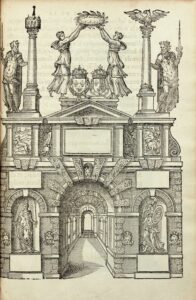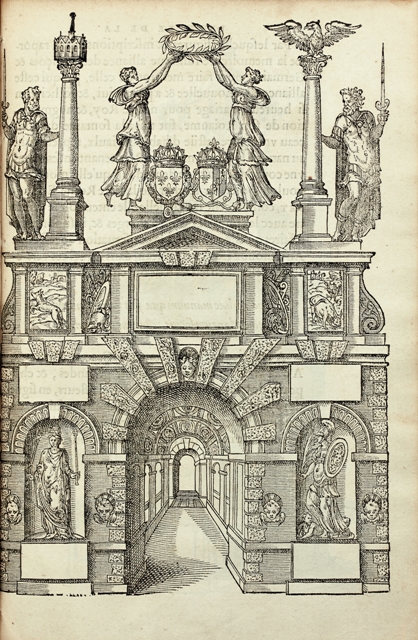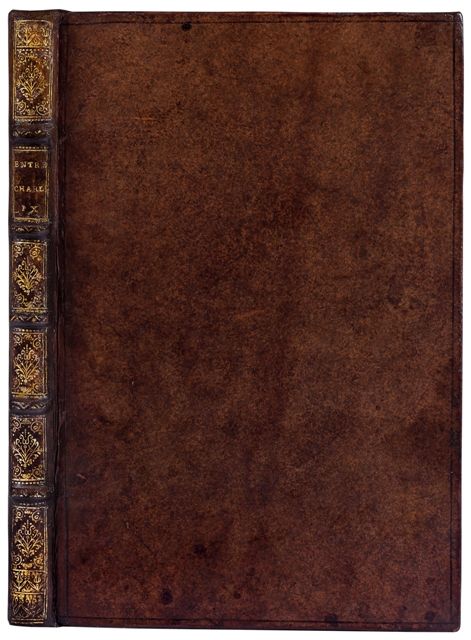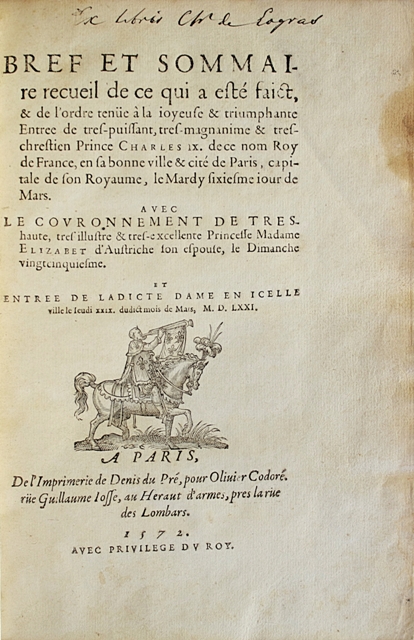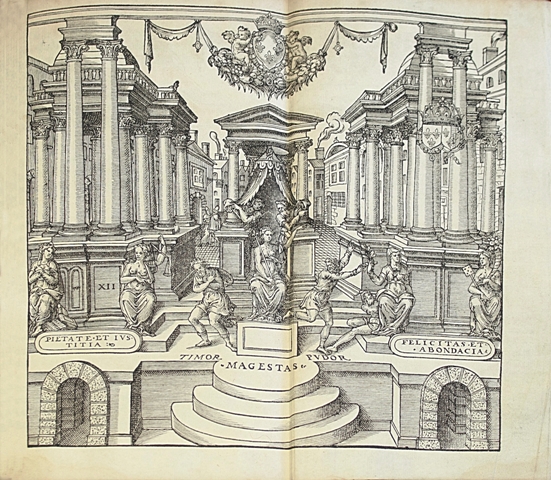Paris, Denis du Pré, 1572.
4to [235 x 157 mm] of 53 ll., (1), 9 full-page engravings in the text and one folding engraving out of pagination ; 10 ll., 26, (2) ll. including 1 bl., 9, (2) bl.ll., 6 full-page engravings in the text. Handwritten manuscript on the title. Bound in full granite-like calf, blind-stamped fillet on the covers, spine ribbed and decorated, mottled edges. Old restorations on the spine. Early 18th century binding.
First edition of one of the most beautiful entries of the French Renaissance containing several plays by Ronsard, Antoine de Baïf, Amadis Jamyn, Jean Dorat, Du Faur de Pibrac, Pasquier,… in first edition. Mortimer, French, 205-206; Rahir, Dutuit, 676; Picot, Rothschild, 3117; Brunet, II, 1001; Pichon, 4897; Fairfax Murray, French, 152.
One of the beautiful French celebration books of the 16th century recounting the coronation of Queen Elisabeth of Austria, wife of Charles ix and daughter of the Emperor Maximilian II, which took place in the Abbey of Saint Denis, as well as the entry of the sovereigns in the capital.
The work was written by the Parisian municipal magistrate Simine Bouquet who was charged by his colleagues at the city hall to organize the celebration and to coordinate the order of the decors; he had entrusted Ronsard and Dorat with the direction, they decided the theme: the happy meeting between France and Germany. These two poets called in Germain Pilon for the sculptures, in Le Conte for the carpentry’s works, and for the perspectives and the paintings in Pierre d’Angers and in Nicolo dell’Abbate, the famous emulator of Fontainebleau’s Primaticcio.
The edition encloses 16 full-page woodcuts including 1 folding plate, made by the precious stones cutter and engraver Olivier Codoré, abbreviated name, according to Mariette, of the valet and semi-precious stones engraver of the future Henry IV, nicknamed Coldoré because of the abundance of necklaces he exhibited with pleasure.
The illustration depicts the ephemeral architectures, triumphal arcs, ivy and leaves cradles, fountains…put on the royal cortege’s way. It is interesting as it is, itself, “transformable”. These ceremonies had been delayed for about ten years, Charles IX being able to make his solemn entry in the capital only thanks to the recent Saint Germain peace conclusion, on August 11th, 1570, which put a temporary end to ten years of religious wars.
“The king’s entry is illustrated with 10 figures including 9 that measure 200 x 140; the tenth, bigger (208 x 212) depicts the perspective of the painting put place du Chatelet. These woodcuts offer similarities with those of the Entry of Henry II. The Entry of the Queen is illustrated with 6 woodcuts made each of two parts: the lower part is the exact reproduction of the corresponding figure of the King’s entry; the upper part alone was re-engraved, with different characters. The Queen having arrived 23 days after the king, we had to keep the same decors and replace the allegories and inscriptions with other ones more suitable. All this decoration would be by Codoré as it is hinted in the privilege. According to Mariette, Codoré would be the nickname of Fontenay, Henry IV’s semi-precious stones engraver.” (Brun, Le Livre français illustré de la Renaissance, p. 181).
The volume encloses a mention of first state: the word “vouloir” l.34 v° wasn’t added to line 7.
Brunet (II, 1001) mentions “On some copies the page ‘Simon Bouquet’ is followed by a play in verse signed E. Pasquier Parisien entitled ‘Au Roy Congratulation de la paix faicte par sa Majesté entre ses sujets l’onzieme jour d’Aoust 1570’, 9 leaves”. Our copy is one of the very few to include this play in verse by Pasquier.
The Queen being ill, another celebration was held for her three weeks later. The same temporary architectures were used but they were decorated with new allegorical figures.
A precious wide-margined and unwashed copy, preserved in its 18th century binding. Copies in ancient binding are rare, most of them having been rebound –and washed at the same time– at the end of the 19th century.
